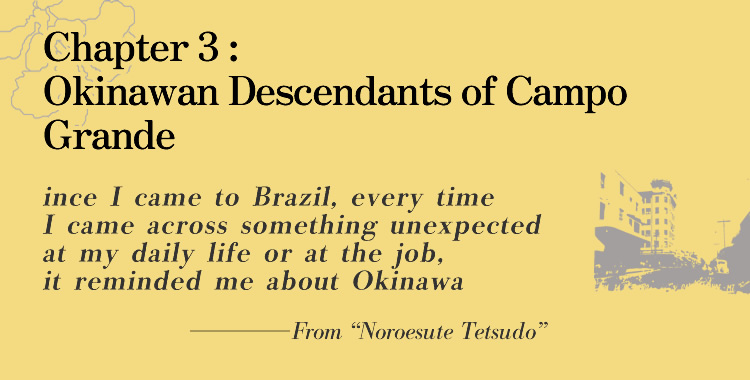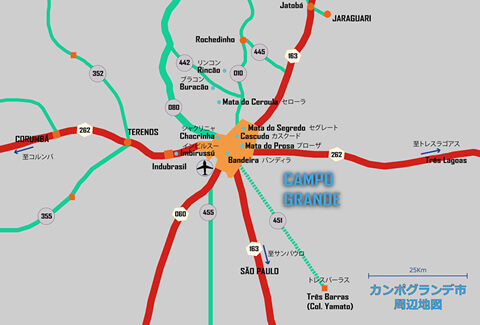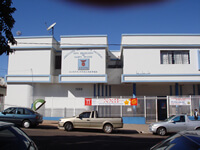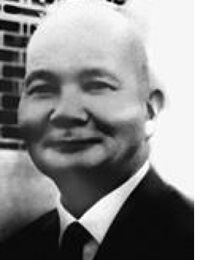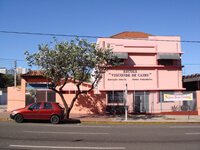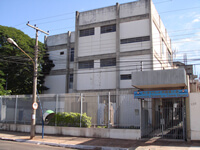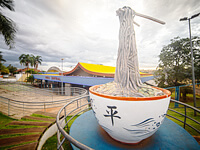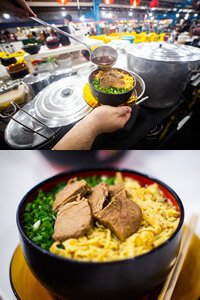01. Campo Grande City's History
The history of the City of Campo Grande begins with the joint construction of a small camp called the Santo Antônio de Campo Grande by José Antônio Pereira and Manoel Vieira de Sousa in 1877. On August 26, 1899, the camp was officially emancipated by the government of the State of Mato Grosso as the municipality of Campo Grande.
After the Noroeste Railway, which connects Porto Esperança and Três Lagoas, was ready in August 1914, it evolved as a strategic point that connected the states of São Paulo and Mato Grosso, where supplies are concentrated, being elevated to the category of City in 1918.
With the establishment of the Noroeste Railway, among the Japanese who took part in the construction of the railway, emerged people who settled in Campo Grande, either by becoming employees of the Railway Company, or by providing firewood and railroad ties autonomously. There were also people who cultivated the surrounding farms using the capital accumulated as railroad construction workers.
The population of Campo Grande around 1914 was about 1,800 people and grew rapidly to about 5,600 in 1922 and then to about 13,000 people in 1932. One of the reasons for this growth included the transfer of the Headquarters of the Brazilian 9th Military Region, thus becoming an important strategic point of the country. At the same time, the Japanese population of 200 people (50 families) in the 1920s grew significantly in 1927 to 897 people (223 families), most of them being Okinawan emigrants. It is believed that this was due to the increase of the immigration by invitation from their homeland, families growing by the birth of more children, and the migration of people from the surrounding colonies growing up. In addition, construction of skyscrapers began in the 1930s and Campo Grande, which was also known as .44 caliber pistol (Pistola calibre 44), where beasts and wild animals walked like the owners of the land, developed becoming one of the most notable major cities in the country.
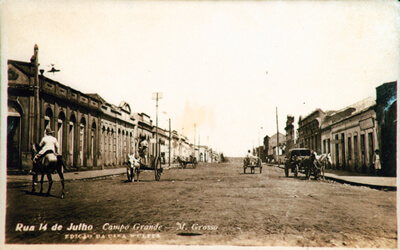
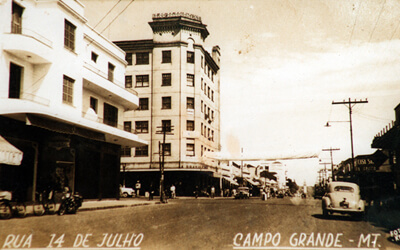
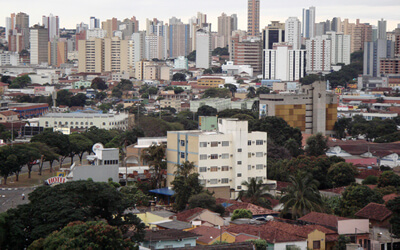
02. Okinawan Emigrants Who Settled in Campo Grande
When the construction work on the Noroeste Railroad ended in 1914, some of the Okinawan emigrants who participated in the construction settled in Campo Grande. Kosho YAMAKI and Itiei MIYAHIRA are said to have been the first to start farming vegetables on Dom Aquino Street. Later, the couple Kamado and Uto OSHIRO, Jiro OSHIRO, Gentai HOKAMA, Toku AKAMINE, and Kame AKAMINE jointly bought land in Chacrinha, working with horticulture. Following this, the KASATO-MARU emigrants from 1915, Kisa AKAMINE, Ushi HOKAMA, and Toku AKAMINE also bought land together, and grew rice, corn, and vegetables.
Gonsiro NAKAO, Kosuke GUENKA, and Zenei NAKAO, who emigrated from Haneji-son to Peru, settled in Mata do Segredo in 1917, and grew coffee, bananas, and sugarcane. The Bandeira Colony, begun by Tokichi ARAKAKI and Seiko YONAMINE, both from Ozato-son, in 1918 were near the urban area and as in addition to the cultivation of vegetables had pig and chicken farming, eventually called Campo Grande's Kitchen.
Okinawan emigrants made efforts to educate the youth and in 1918 founded the Hanjya Japanese Language School in front of Campo Grande Station. The school changed its address and was called the Japanese School, which also taught the Portuguese language. Then, with the rise of nationalism and discriminatory treatment of Japanese immigrants, in 1927 the school's denomination was changed to Escola Visconde de Cairu, still used this day.
The Colonies Created Until 1930 Around Campo Grande
| 1914 | Chacrinha ※ |
|---|---|
| 1917 | Mata do Segredo |
| 1918 | Bandeira ※ |
| 1920 | Imbirussú ※ |
| 1924 | Mata do Prosa ※ |
| 1925 | Cascudo ※ |
| 1926 | Mata do Ceroula |
| 1927 | Rincão |
| 1929 | Buracão |
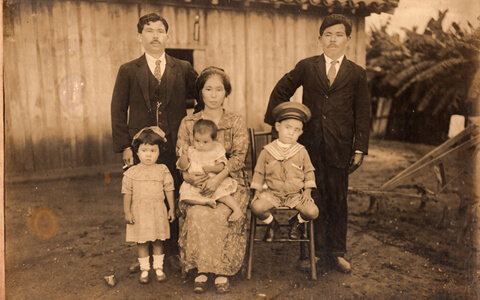
Collection of descendants of Yokichi GUENKA
Offered by Hiroaki MARUYAMA
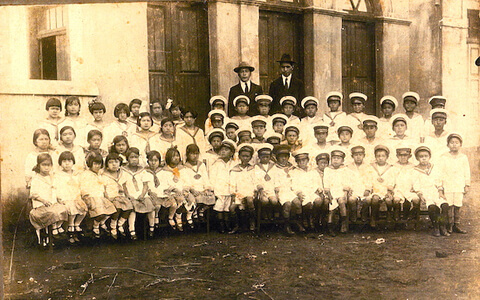
Collection of the Campo Grande Japanese Brazilian Cultural Sportive Association
Offered by the Institute for Latin American Studies at Rikkyo University
03. The Development of the Okinawan Organization of Campo Grande
Foundation of the Japanese Community Association in Campo Grande
Kosho YAMAKI, who settled in Campo Grande in 1914, opens a hotel. Preaching the need for a Japanese organization, the Japanese Community Association in Campo Grande was inaugurated in 1916, where Yamaki became its first president. There was a moment of interruption of activities during the chaos of the war, but reorganizing after the war, changed the name to RENGO NIHONJINKAI (Union of Japanese Association) in 1957, Campo Grande Japanese Brazilian Sportive Association in 1960 and Campo Grande Japanese Brazilian Cultural Sportive Association in 1962, maintaining its activities until the present times.
Cooperative of Alcoholic Beverage Producers of Campo Grande
In 1919, Gonsiro NAKAO and others built the first Pinga distillery in the Mata do Segredo that has sugarcane as raw material. There were not few the people who were comforted by drinking alcohol in a land far from their homeland, and as the taste of the pinga was good, it was also successful among Brazilians. Later, more than ten pinga distilleries were built around Mata do Segredo and in 1932 the Cooperative of Alcoholic Beverage Producers was founded (having Takemori OSHIRO as the first president). However, sales fell in 1939 after the construction of a large distillery by a Brazilian and in 1940 the cooperative fell apart.
Cooperative of Campo Grande Industry
On May 5, 1935 is founded the Cooperative of Industry, having Takemori OSHIRO as its first president. With the participation of 152 associates, Gonsiro NAKAO was elected to accounting. At first, they did not have their own facilities and used the warehouse, as well as the processing machines for rice and coffee that were owned by Gonsiro NAKAO. The warehouse was then transferred to the land of the cooperative in 1941 and after overcoming the Great Drought of 1944, they got their own equipment for processing rice and coffee. In 1954 he created the purchasing department, which continues to deal with agricultural utensils, pesticides, fertilizers and seeds to this day.
Okinawa Association of Campo Grande
The pre-war Campo Grande Okinawan Association was founded in 1922 with Kame CHINEN as its first president. Helping the poor and sick of the colonies, founding a primary school, improving Okinawans' image towards Brazilians, cultivating the Japanese spirit, and promoting immigration by calling to them from their homeland were part of their foundation's goals, that is, they came together to educate the youth and improve the life in the colonies. Then, in 1926, KYUYO KYOKAI was founded, and the Campo Grande association was reorganized as its branch. As the first president, Kasuke SHIROMA was chosen, who measured no efforts to resolve prejudice against Okinawans and irregular issues related to the intermediary agents for the immigration by call.
However, with the outbreak of World War II, Japanese groups had their activities limited until their shutdown in December 1941. After the war, the Okinawan association resumed activities in 1953.
04. Campo Grande and Okinawa Prefecture
Treaty of Sister Cities between the state of Mato Grosso do Sul and Okinawa Prefecture
When Governor Junji NISHIME visited São Paulo in August 1978, Diogo NOMURA, the federal deputy of the Chamber of Deputies of the Federative Republic of Brazil, suggested the sister city relationship to strengthen the friendship relations between Okinawa Prefecture and Brazil. Thus, the ZAIHAKU OKINAWA KENJIN KAI (Okinawa Kenjin Association of Brazil) studied which place could do the treaty and the conclusion was that the state of Mato Grosso do Sul, recently dismembered from the state of Mato Grosso and where are many Okinawans were, was chosen as the candidate.
On April 22, 1986, Ramez Tebet, the deputy governor of the state of Mato Grosso do Sul, visits Naha City in Okinawa and signs the Sister City Treaty with Okinawa Prefecture.
The state of Mato Grosso do Sul is located in the central-eastern region of Brazil, bordering Bolivia and Paraguay. Its area is equivalent to 157 times the area of Okinawa Prefecture. It is estimated that in 2006, the number of Japanese and descendants residing in its capital, Campo Grande is about 20,000 inhabitants and they say that of these, 70% are Okinawans.
Okinawa Sobá's culture spreading to the world
The SOBA in Brazil is so widespread among Brazilians that it refers to Okinawa Sobá, having been listed by the municipality as an Intangible Cultural Heritage in 2006. The gigantic Monument to Sobá placed in the Central Market has become a tourist atraction. Okinawa Sobá has established itself as part of Campo Grande's cuisine, to the point of holding the Festival do Sobá (Sobá Festival) in 2014 to celebrate the 100 years of Okinawan immigration. And in October 2017, Okinawa Sobá is chosen by the population as the representative dish of Campo Grande.




